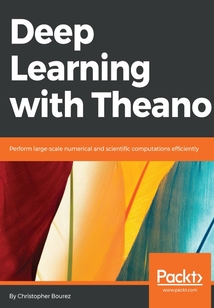舉報 

會員
Deep Learning with Theano
最新章節:
Index
Thisbookisindentedtoprovideafulloverviewofdeeplearning.Fromthebeginnerindeeplearningandartificialintelligence,tothedatascientistwhowantstobecomefamiliarwithTheanoanditssupportinglibraries,orhaveanextendedunderstandingofdeepneuralnets.SomebasicskillsinPythonprogrammingandcomputersciencewillhelp,aswellasskillsinelementaryalgebraandcalculus.
目錄(139章)
倒序
- 封面
- 書名頁
- Deep Learning with Theano
- Credits
- About the Author
- Acknowledgments
- About the Reviewers
- www.PacktPub.com
- eBooks discount offers and more
- Customer Feedback
- Preface
- What this book covers
- What you need for this book
- Who this book is for
- Conventions
- Reader feedback
- Customer support
- Chapter 1. Theano Basics
- The need for tensors
- Installing and loading Theano
- Tensors
- Graphs and symbolic computing
- Operations on tensors
- Memory and variables
- Functions and automatic differentiation
- Loops in symbolic computing
- Configuration profiling and debugging
- Summary
- Chapter 2. Classifying Handwritten Digits with a Feedforward Network
- The MNIST dataset
- Structure of a training program
- Classification loss function
- Single-layer linear model
- Cost function and errors
- Backpropagation and stochastic gradient descent
- Multiple layer model
- Convolutions and max layers
- Training
- Dropout
- Inference
- Optimization and other update rules
- Related articles
- Summary
- Chapter 3. Encoding Word into Vector
- Encoding and embedding
- Dataset
- Continuous Bag of Words model
- Training the model
- Visualizing the learned embeddings
- Evaluating embeddings – analogical reasoning
- Evaluating embeddings – quantitative analysis
- Application of word embeddings
- Weight tying
- Further reading
- Summary
- Chapter 4. Generating Text with a Recurrent Neural Net
- Need for RNN
- A dataset for natural language
- Simple recurrent network
- Metrics for natural language performance
- Training loss comparison
- Example of predictions
- Applications of RNN
- Related articles
- Summary
- Chapter 5. Analyzing Sentiment with a Bidirectional LSTM
- Installing and configuring Keras
- Preprocessing text data
- Designing the architecture for the model
- Compiling and training the model
- Evaluating the model
- Saving and loading the model
- Running the example
- Further reading
- Summary
- Chapter 6. Locating with Spatial Transformer Networks
- MNIST CNN model with Lasagne
- A localization network
- Unsupervised learning with co-localization
- Region-based localization networks
- Further reading
- Summary
- Chapter 7. Classifying Images with Residual Networks
- Natural image datasets
- Residual connections
- Stochastic depth
- Dense connections
- Multi-GPU
- Data augmentation
- Further reading
- Summary
- Chapter 8. Translating and Explaining with Encoding – decoding Networks
- Sequence-to-sequence networks for natural language processing
- Seq2seq for translation
- Seq2seq for chatbots
- Improving efficiency of sequence-to-sequence network
- Deconvolutions for images
- Multimodal deep learning
- Further reading
- Summary
- Chapter 9. Selecting Relevant Inputs or Memories with the Mechanism of Attention
- Differentiable mechanism of attention
- Store and retrieve information in Neural Turing Machines
- Memory networks
- Further reading
- Summary
- Chapter 10. Predicting Times Sequences with Advanced RNN
- Dropout for RNN
- Deep approaches for RNN
- Stacked recurrent networks
- Deep transition recurrent network
- Highway networks design principle
- Recurrent Highway Networks
- Further reading
- Summary
- Chapter 11. Learning from the Environment with Reinforcement
- Reinforcement learning tasks
- Simulation environments
- Q-learning
- Deep Q-network
- Training stability
- Policy gradients with REINFORCE algorithms
- Related articles
- Summary
- Chapter 12. Learning Features with Unsupervised Generative Networks
- Generative models
- Semi-supervised learning
- Further reading
- Summary
- Chapter 13. Extending Deep Learning with Theano
- Theano Op in Python for CPU
- Theano Op in Python for the GPU
- Theano Op in C for CPU
- Theano Op in C for GPU
- Coalesced transpose via shared memory NVIDIA parallel for all
- The future of artificial intelligence
- Further reading
- Summary
- Index 更新時間:2021-07-15 17:17:25
推薦閱讀
- DevOps with Kubernetes
- Mobile Web Performance Optimization
- 密碼學原理與Java實現
- 高效微控制器C語言編程
- Selenium Design Patterns and Best Practices
- Programming ArcGIS 10.1 with Python Cookbook
- Expert Android Programming
- INSTANT Mercurial SCM Essentials How-to
- QGIS:Becoming a GIS Power User
- 移動界面(Web/App)Photoshop UI設計十全大補
- Python Web數據分析可視化:基于Django框架的開發實戰
- Java語言程序設計教程
- HTML+CSS+JavaScript網頁設計從入門到精通 (清華社"視頻大講堂"大系·網絡開發視頻大講堂)
- Java程序設計教程
- Web前端開發最佳實踐
- 例說FPGA:可直接用于工程項目的第一手經驗
- MongoDB Cookbook
- Java面試一戰到底(基礎卷)
- Visual Basic 開發從入門到精通
- Hands-On Data Visualization with Bokeh
- Expert Angular
- Instant Highcharts
- 精通Django 3 Web開發
- 天天學敏捷:Scrum團隊轉型記
- 一個APP的誕生:從零開始設計你的手機應用
- Visualforce Development Cookbook
- Mastering Application Development with Force.com
- Learning Geospatial Analysis with Python(Second Edition)
- Android開發寶典
- 前端程序員面試筆試寶典

